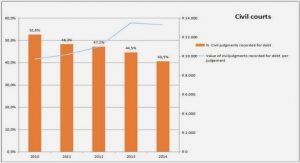Get Complete Project Material File(s) Now! »
Timeline of events in the formulation of the sustainability concept
The following is a study of the evolution of an idea. The idea is one that many have pondered and sought to address, and it has manifested itself in the pursuit of ensuring that current actions achieve justice, equity, alleviation of poverty, and contributed to redistribution of opportunity (Elkington, 1997; 6) ‘without compromising the ability of future generations to meet their own needs’ (UN Brundtland Report, 1987). What could be seen in the early 1990s, however, was that a shift in power was emerging. As big business grew so too did its public influence, and pressure for change became a balance of political, business and social factors. Figure 3.1 draws attention to series of occurrences that have, as Rose and Millar (1992) state, projected the concept of sustainability into the everyday consciousness by stipulating the main contributors to introduction of policy or behavioural change on a broad scale as either political or non-governmental (public). Since these behavioural and political shifts could not occur without tangible implementation, the progression and invention of concepts of built environment design are similarly incorporated to draw specific reference to the relationship between concepts of sustainable development and evolving architectural paradigms. This figure illustrates occurrences within a 70-year period, from 1948 to 2015, selected for the purpose of identifying observable trends in the social or political pressures over periods in human history that included post-war rebuilding, economic recessions, social uprisings for independence and emancipation, as well as the arrival of the Information Age. The period is determined by the researcher to extend over noteworthy disruptions in human history to confirm that observable shifts in pressure exist, and that these shifts will continue. Additional research could be extended to include future occurrences within the proceeding decades to document and confirm the continuation of these trends.
Social networks
The increasing growth and popularity of social networks has created a new world of collaboration and communication. Over a billion individuals around the world are now observed to be connected and networked together with the aim of collaborating, creating and contributing their knowledge (Cheung et al., 2010:1337). Social networking websites constitute virtual communities which allow people to interact and ‘socialise’ online (Cheung et al., 2010:1337). In a non-academic study by internet analyst company Shareaholic, as reported on by the Search Engine Journal (Wong, 2014), it was determined that social media sites such as Facebook, Pinterest, Twitter, LinkedIn, and Google+ accounted for approximately 20% of overall driving of internet traffic to sites. In the later part of 2014, this figure further grew exponentially after it was reported that this figure had grown to 31.24%, replacing search engines and organic search engines such as Google, Bing and Yahoo! in dominating global internet traffic (Wong, 2015). This is an incredible increase in global usage considering that social networking accounted for just 6.5% of all internet traffic in 2007 (Cheung et al., 2010:1337). Facebook alone constituted 15% to 18% of the overall social network share of the internet, making it the most influential social networking platform on the planet by a significant margin (Wong, 2015). Many analysts attribute the global upward trend of interest in social networking to the rise of access to internet and information via mobile devices and supporting networks (Lenhart et al., 2010:5). What this trend implies is that global internet usage is relying less on homepages and search engines, with internet users instead discovering news and personally pertinent information through social media.
1. Introduction
1.1. Statement of the problem
1.2. Importance of the study1.3. Intended beneficiaries of the study
1.4. The researcher’s expertise to comment on the topic
1.5. Assumptions
1.6. Delimitations
1.7. The purpose of the study
1.8. The research objectives
2. Research methodology
2.1. Introduction
2.2. The research context
2.3. The research paradigm
2.4. The research design and method
2.5. Research instruments
2.6. Determination of problem statements addressed in the research process
2.7. Organisation of the study
3. Status quo of sustainable development theory in the built environment
3.1. Sub-problem One
3.2. Hypothesis
4. Sustainable development in the Information Age
4.1. Sub-problem Two
4.2. Addressing hypothesis two
5. Establishing criteria for integration of concepts of ICT, knowledge-based development and sustainable development within the built environment
5.1. Sub-problem three
5.2. Addressing hypothesis three
6. Proposal for a new sustainable development model and architectural design methodology
6.1. Sub-problem four
6.2. Addressing hypothesis four
7. Conclusions and recommendations
7.1. Summary of findings
7.2. Conclusions
7.3. Implications for existing theory
7.4. Recommendations
7.5. Suggestions for future research
7.6. Closing statement
8. Bibliography
8.1. Further reading






